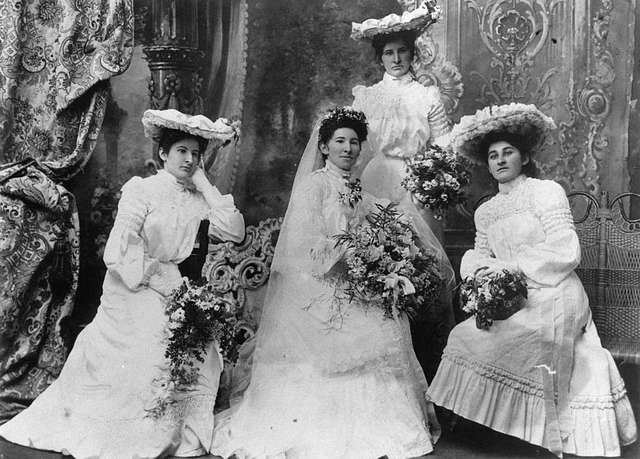Last Updated on February 14, 2025 by Ruby And The Wolf
Queen Victoria’s revolutionary choice of a white wedding gown in 1840 changed bridal fashion forever – but the real story behind why wedding dresses are white might surprise you.
The Pre-Victorian Era: A Colorful History of Wedding Attire
Before Queen Victoria’s trend-setting white wedding dress in 1840, the bridal fashion landscape was a vibrant tapestry of colors and traditions. Wedding attire varied significantly across regions, social classes, and cultural backgrounds, with brides often choosing dresses that could be worn again for special occasions. During the Renaissance period, wealthy brides typically wore rich jewel tones like deep blues, purples, and crimsons, which symbolized their status and family wealth.
- Medieval brides often chose blue, representing purity and the Virgin Mary
- Green was popular in the 15th century, symbolizing fertility and growth
- Red was common among lower-class brides, signifying joy and celebration
- Black wedding dresses were fashionable in 17th-century Spain, representing the bride’s lifelong devotion
Regional variations played a significant role in bridal fashion choices. In Scotland, tartans were commonly incorporated into wedding attire, while French brides often favored pastel shades. The choice of wedding dress color was heavily influenced by practicality, available materials, and local customs rather than any universal tradition.
Queen Victoria’s Game-Changing Decision
The wedding of Queen Victoria to Prince Albert on February 10, 1840, marked a pivotal moment in bridal fashion history. Against the conventions of her time, Victoria chose to wear a white satin gown trimmed with Honiton lace. This decision was revolutionary because white was not yet associated with weddings – in fact, it was considered a color of mourning in parts of Europe.
Victoria’s choice was driven by several factors. First, she wanted to support British industry by showcasing English lace. Second, she aimed to make a statement as a monarch marrying for love rather than political alliance. The dress featured a fitted bodice, full skirt, and elaborate lace details, creating a silhouette that would influence wedding fashion for generations to come.
The Status Symbol of White
The adoption of white wedding dresses as a status symbol was intrinsically linked to the practical challenges of maintaining white fabric in the Victorian era. Before modern cleaning methods, keeping a white dress pristine was nearly impossible, making it a clear indication of wealth and social status. Only the most affluent families could afford:
- Multiple fittings and alterations required for a custom white gown
- High-quality white fabrics that wouldn’t yellow quickly
- Professional cleaning and storage of the delicate garment
- The luxury of wearing a dress only once
The economic implications of choosing white extended beyond the dress itself. It represented a family’s ability to host an elaborate celebration and showcase their daughter in an impractical yet fashionable garment. This social statement through bridal fashion helped establish white as the aspirational choice for brides across social classes.
Cultural Evolution of the White Wedding Dress
The spread of white wedding dresses as the standard was dramatically accelerated by Victorian media and the emergence of photography. Fashion magazines of the 1840s and 1850s widely publicized Queen Victoria’s wedding dress, making it the most influential bridal gown in history. The advent of photography played a crucial role, as white photographed well and created striking images that could be shared and admired.
Religious and moral associations soon became intertwined with the white wedding dress tradition. The color white, already associated with purity in Christian symbolism, became increasingly linked to the concept of virginal purity and moral virtue. This religious connection helped cement white as the traditional choice for Christian weddings across Western cultures.
Alternative Wedding Dress Traditions
- Chinese brides traditionally wear red, symbolizing luck and prosperity
- Indian weddings feature vibrant colors, with red being particularly auspicious
- Japanese brides often wear multiple outfits, including the white shiromuku and colorful uchikake
- Modern African weddings frequently incorporate traditional textiles and bright colors
Historical alternatives to white wedding dresses have existed across various cultures and time periods. In many Asian cultures, red remains the traditional choice for wedding attire, representing good fortune, joy, and celebration. These diverse traditions remind us that white wedding dresses are a relatively recent Western convention rather than a universal standard.
The Modern White Wedding Dress
Today’s wedding dress market reflects both tradition and changing attitudes toward bridal fashion. Recent studies show that approximately 83% of Western brides still choose white or ivory for their wedding gowns, demonstrating the enduring influence of Victorian traditions. However, contemporary brides are increasingly willing to experiment with:
- Subtle color variations like blush, champagne, and pearl
- Colored accents and embellishments
- Non-traditional silhouettes and styles
- Complete departures from white in favor of bold colors
The modern bride’s choice of dress color often reflects personal style and values rather than strict adherence to tradition. This shift represents a broader trend toward personalization and self-expression in wedding celebrations.
Conclusion: A Tradition Born of Romance
The white wedding dress tradition, born from Queen Victoria’s romantic choice in 1840, has evolved into a powerful symbol of wedding celebrations across much of the world. While its origins lie in royal fashion and status symbolism, its endurance speaks to the emotional resonance of starting anew in pure white. As we move further into the 21st century, the tradition continues to evolve, with 15% of modern brides now choosing alternative colors, demonstrating that while Victoria’s influence remains strong, personal choice and individual expression are becoming equally important in bridal fashion.
FAQ
What does it mean when a woman gets married in a black dress?
While the traditional white wedding dress was meant to symbolize innocence, a black wedding dress depicts elegance, power, mystery, and individuality.
Sources
[1] https://thewhitecollection.com.au/blogs/news/the-reason-why-most-brides-wear-white-dresses-on-their-wedding-day
[2] https://www.theknot.com/content/can-i-wear-white-wedding-gown
[3] https://www.britannica.com/story/why-do-brides-wear-white

